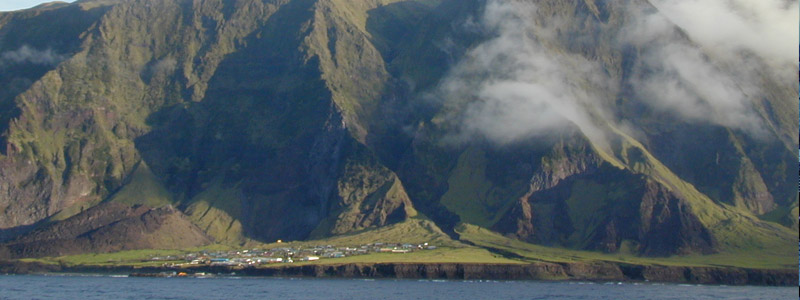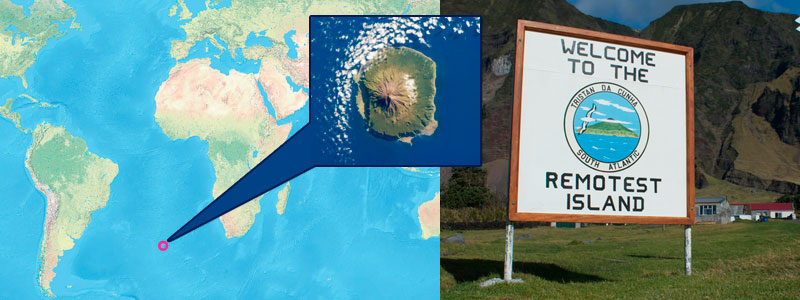Tristan da Cunha (pronounced ‘Tristan da Coonah’) is the most remote populated island in the World. Named after its Portuguese discoverer, Tristao da Cunha in 1506. The island was first settled in 1810 by an American party of 4 men (3 of whom perished) who wanted to rule it as ‘the Refreshment Islands’, but that didn’t work out so well. Six years later in 1816 the island became a British outpost, basically because it was close to South Africa and South Africa was under British rule.
It’s in a very isolated patch of the southern Atlantic Ocean. The nearest significant population is located 2,816 kilometres (1,760 miles) away in Cape Town, South Africa. The island is 8,589 kilometres (5,337 miles) from London, where it’s effectively governed from. It’s beside another island named Inaccessible Island. Aptly named due to its sheer cliffs that span almost all of its coastline.
Tristan da Cunha is a 98 square kilometre island that lies towards the bottom middle of the Indian Ocean. It’s almost the same distance from South America and Africa.

Tristan da Cunha. Courtesy Flickr
Visiting Takes a 7 Day Boat Ride
There’s no airport. And so, without an airport, the only way in and out is by boat. And it takes a 7-day boat ride through notoriously rough seas, with trips typically leaving every 3-5 weeks.
To visit the island you must travel by boat from Cape Town, South Africa. The boat ride takes 7 days across the choppy Atlantic seas. But before you go, make sure you seek visiting approval from the island first. It’s rare to be rejected for a visit, but it can happen. In 1986, Simon Winchester wrote a book after visiting the island. And the island council didn’t much like its content. As a result, when Winchester subsequently tried to visit again in 1998 and 2008, he was denied visitation rights. Yup, he sailed for 7 days each time, but was denied entry. Ouch. Hopefully he enjoyed the food on the boat.
Medical emergencies or other important visitations can also bump eager visiting tourists – as ships typically only offer 12 passenger spots (any more and they would need a doctor on board). The island does have one doctor on rotation, supported by local nurses – but a dentist only visits the population once a year for a few weeks.
Tristan De Cunha’s Population
Its population of over 250 originates from 15 people who emigrated to the island between 1816 and 1908. Today all residents share one of 7 surnames. Residents live within 120 homes and are all administration, farming or fishing families. Over 80% of the island’s income is generated through fishing for crawfish (crayfish), which is exclusively supplied to one business (Ovenstone) for distribution at Capetown. The British pound is the territory’s currency.
Tristan da Cunha has one road. But despite this, cars are popular – and complement the bus service. Visitors to the island enjoy the mountain summiting, fishing trips, bird watching and even golf.
It also has a really big volcano – Queen Mary’s Peak. At 2,062 metres (6,765 feet). It erupted on 10 October 1961, causing the population to evacuate to nearby Nightinggale island, before being evacuated to the UK (via Capetown) for two years.
According to a report on their UK stay, Tristanians had “little communication with the English. They seldom left their enclosed village except for work and shopping trips.” Even the distinctiveness of the English dialect spoken on the island emerged as a socio-linguistic marker for defining the collective identity of the evacuees. As a conclusion, “an increase in the Islanders’ awareness of their peculiar identity as a value” occurred.
First Hand Account of the Island
Colin recollected that Tristanians were a friendly, yet reserved people. This reservation likely stemmed from the 1961 volcano eruption and subsequent evacuation to South Hampton in the UK. This temporary visit seemed like an alien land to many Tristanians. The media at the time were keen to point out the differences, rather than embrace the commonalities.
The few tourists to the island are usually very well travelled and are looking for a new challenge. Some have a semi-connection to the island, either knowing someone or having a distant relative who had previously visited. Colin visited the island for the challenge of reaching “the most remote settlement on the planet”. He also talks fondly about it.
Most tourists stay a few days, awaiting the next return ship.
Colin also mentioned that Tristanians really only ventured to Cape Town for a specific purpose, such as education (e.g a diesel engine mechanic’s course) or to see a medical specialists. Whimsical visits aren’t on the cards as return trips can take many weeks, sometimes months.
You can also visit the official Tristan De Cunha website. I have heard that they respond to emails. But as at the time of writing, I have received no response.

